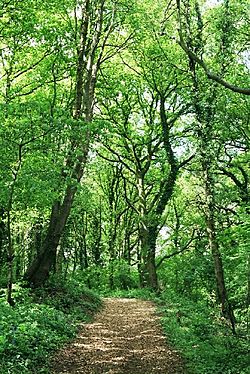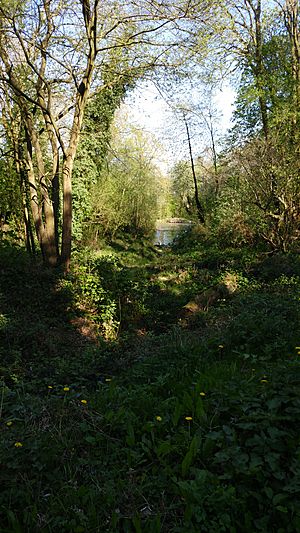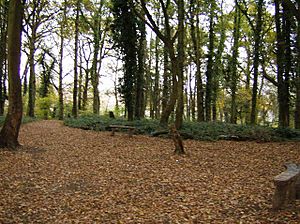Lousehill Copse facts for kids
Quick facts for kids Lousehill Copse |
|
|---|---|

Lousehill Copse
|
|
| Lua error in Module:Location_map at line 420: attempt to index field 'wikibase' (a nil value). | |
| Type | Local nature reserve |
| Location | Tilehurst, Reading, UK |
| Area | 13.03 hectares (32.2 acres) |
| Created | 1992 |
Lousehill Copse is a special place in Tilehurst, a part of Reading, England. It is a local nature reserve, which means it's a protected area for nature. The reserve is about 13 hectares big. That's like 26 football fields! The Reading Borough Council helps to look after it.
Most of Lousehill Copse is an old, natural forest. It has a lovely pond and is surrounded by houses. The northern part of the reserve is called Comparts Plantation. This area is a wide, grassy field. Dee Road crosses the southern part of the reserve.
Lousehill Copse is also part of a bigger group of green spaces. It joins Blundells Copse and McIlroy Park to form the West Reading Woodlands. These woodlands are important for local wildlife.
Contents
History of Lousehill Copse
The forest at Lousehill Copse is very old. Experts believe it has been a woodland for over 300 years. Imagine all the history these trees have seen!
In 1992, Lousehill Copse was officially named a Local Nature Reserve. This helps to protect its plants and animals for everyone to enjoy.
Animals of Lousehill Copse
Many different animals live in Lousehill Copse. It's a great place for them to find food and shelter.
Birds of the Copse
You can spot many kinds of birds flying around Lousehill Copse. Here are some of them:
- Red kite
- Great tit
- European robin
- Eurasian magpie
- Eurasian bullfinch
- Goldcrest
- Eurasian treecreeper
- Long-tailed tit
- Lesser spotted woodpecker
- Great spotted woodpecker
- European green woodpecker
- Tawny owl
- Jay
Plants of Lousehill Copse
Lousehill Copse is home to many interesting plants and trees. They make the reserve a beautiful and green place.
Trees in the Woodland
The woodland has many types of trees, including:
- Tilia × europaea (a type of lime tree)
- Quercus robur (the English oak)
- Taxus baccata (yew tree)
- Betula pendula (silver birch)
- Fagus sylvatica (beech tree)
- Chestnut
- Hazel
- Ilex aquifolium (holly)
Other Plants
You can also find these plants growing in the reserve:
- Hyacinthoides non-scripta (bluebells)
- Ulex (gorse)
- Genisteae (broom)



